Typically, most marketing teams are focused on driving traffic toward websites, in hopes that the traffic converts from leads to sales. However, that is only half of the battle; the sales managers must also focus on hunting and closing sales opportunities in order to fulfill quotas. Optimizing a website can help it generate more business. And that’s where conversion rate optimization (CRO) comes in. In this article, we’ll give you a basic overview of what CRO is, how to determine your conversion rates, and which tests you can start immediately.
But before you start optimizing your website, it’s important to first assess what’s there. Are you missing any important elements that would improve your conversion rates? Consider your website’s conversion goals and the landing pages you’ve created. Look for missing elements, such as social media integration, and make sure your site is optimized for conversion.
What Is Conversion Rate Optimization
Conversion rate optimization is a method of increasing the percentage of clicks from an email or invite to an app or website through the troubleshooting and testing of different sites. It typically involves performing insights by analyzing factors that are important to people’s experience with your website or apps.
Conversation rate optimization (CRO) is the process of making changes to a website with the goal of increasing the percentage of visitors who take the desired action, such as filling out a form or clicking a button. CRO is all about getting more out of your website traffic by increasing the number of people who do what you want them to do.
It increases the percentage of the website’s or mobile app’s conversions. This entails enabling the site or app automatically perform actions that increase the likelihood of a conversion. Conversion rate optimization entails analyzing the performance of the website or mobile app, and its elements, and identifying the cause of minimal conversions.
A conversion rate is a benchmark number for determining the success of a website. It is usually expressed as a percentage to show how many users responded to a given marketing campaign or advertisement
The basic elements determine the success of your website, including website design, the content of your website, and the performance of your website. A very high conversion rate reveals that your website is well-designed, formatted effectively, and appealing to your target audience. Poor conversion rates are rarely the result of website performance or design. Slow load times, broken forms, or copy that doesn’t convey the value of the offer is the most common missing ingredients.
Why Is Conversion Rate Optimization Important
It is critical to use conversion rate optimization to lower your acquisition costs by getting more value out of your existing visitors and users. More importantly, you can increase your revenue per visitor, acquire new customers, and grow your business by optimizing your conversion rate.
So, why is CRO so important for the sales team?
An optimized landing offer, for example, can increase conversions by 15%. As the conversion rate is improved, the number of conversions generated proportionally increases from 100 per 30 days to 500 per 30 days. While there may be room for improvement when it comes to increasing conversions on your website or mobile app, the best companies are constantly upgrading their information and looking for ways to improve user experience.
How To Implement A Conversion Rate Optimization Strategy
Here are four areas where you can experiment with conversion rate optimization.

1. Landing Page Optimization
When it comes to landing pages, conversion rate optimization can help convert more users. If you know the nature of your sales funnels, you can determine which leads are most likely to convert. Think of a funnel as a collection of activities every user goes through when they are trying to get from a website to a sale. Each of these steps is a conversion opportunity.
Some of the most common elements of a landing page include:
1. A graphic that captures the reader’s attention.
2. A headline and subtitle that piques interest and offer value.
3. A button or call-to-action that helps users take the next step.
4. A form that needs filling out, to help users give you their contact information.
What can we learn from landing pages?
First, they work. They are the foundation of your conversion funnel. The best landing pages are designed to draw users in and keep them engaged.
Second, they are not the end of the conversion funnel. They are the beginning of the funnel.
2. Homepage
Maps must be carefully thought of when creating a homepage. A designated map is seen as the beginning of a website. It is an opportunity to retain visitors and guide them further into the website.
This is a seamless conversion that involves highlighting product information, advertising a free signup button, or even offering a chatbot during the browsing experience. With this strategy, you can produce better conversions while forcing visitors to interact and engage with your website or marketing platform.
3. Pricing Page
For a pricing page to convert buyers, a company should modify the pricing intervals (e.g. price-per-year vs. price-per-month), as well as explain each of the features of an offer, including describing the call number for customers to contact the company directly for a better offer. Alternatively, the company can add a simple pop-up form that allows customers to ask a question in order to better determine the company
Increasing website visitor personalization by using a popup that will appear when a link is clicked can drive home incredibly persuasive messages. When a visitor first arrives at the product pricing page, said service, add a simple email opt-in form and click on the displayed
4. Blog Page
A blog page is a huge conversion opportunity for a website. A blog can help build a brand, generate leads, and increase website traffic. Blogs can be used to achieve these goals and are usually hosted on a separate website by creating a sub-domain or on a different page on the same website.
A good blog is one that is updated on a regular basis and has a defined goal. A blog post should be focused on informing and engaging readers. It should be written in plain and short terms that are easy to understand. It should be clear, concise, and useful.
5. Business Branding
The Branding of your business is the art of creating a unique identity that distinguishes a business from others in both its industry and the marketplace. According to HubSpot, a successful brand is one that is relevant, unique, and consistent. Business branding is the act of creating a unique identity through a consistent visual language.
The main elements of a brand are:
1. Logo.
2. Color palette.
3. Typography.
4. Branding elements.
5. Brand voice.
6. Brand Customer Services.
7. Brand Positioning. , and many more.
The logo is the most important element of a brand. It should be simple, clear, and easy to recognize. The logo should contain the appropriate colors, fonts, and imagery to help your business stand out.
Conclusion
Let’s put it simply, CRO is about making it as easy as possible for people to take the action you want them to take on your website. Whether that’s signing up for your email list, buying a product, or downloading a white paper, CRO is all about making it easy for people to do what you want them to do as it is the process of optimizing your website to convert more of your traffic into leads and customers.
Before you can judge when it’s time to invest in paid traffic, you must first figure out what to optimize for. How do you know when your business is ready to begin the process?
The answer is simply Yes… Every business needs conversion rate optimization so start optimizing today.

